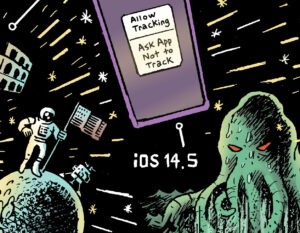Criteo expects 2025 to be a pivotal year for its retail media business.
The end-to-end commerce media platform has already made a major change this year by hiring a new CEO in Michael Komasinski, Dentsu’s former CEO of the Americas.
According to Criteo CRO and President of Retail Media Brian Gleason, Komasinski’s experience leading a major agency holding company should be invaluable in helping Criteo navigate the changing agency landscape, as holdcos consolidate and build out their in-house tech capabilities.
“Agencies play a critical role in Criteo’s ecosystem, bridging the gap between brands, retailers and technology platforms to help create seamless and impactful advertising strategies,” Gleason told AdExchanger. “As brands increasingly look for ways to reach consumers at the point of purchase with personalized and measurable campaigns, we see significant opportunities to drive innovation.”
Gleason shared Criteo’s priorities for capitalizing on those opportunities in retail media.
AdExchanger: What’s on Criteo’s agenda this year?
BRIAN GLEASON: We’re building out demand-side capabilities. Our sponsored product ads were the first big [pool of] media available for retailers. But display was run on Google Ad Manager, and there was no way to connect them.
There are three major focuses on the retail media side. How do we make sure our demand platform offers scalability, meaning access to our 225 retailers? In terms of channels, we’re looking at display, sponsored product ads and off-site media. And then providing standardized measurement and attribution across all those things.
What’s Criteo’s plan for winning retail media market share?
Amazon has 70% of the overall share of retail media, but 30% of gross merchandise value, and they’ve done a fantastic job of pioneering the market. Now brands are saying, “I need to get to more of these retail media networks, but I need an efficient way to do that.” Criteo has filled that position. In most cases, Amazon and Criteo [together] gives you retail media.
How will the retail media market evolve this year?
One out of every four dollars is going to be spent in retail media. And national digital still hasn’t really come into the space. We’re going to see more spend coming in from other channels, whether it’s social or display.
A few retailers are looking more like media companies. I loved what Walmart did with Vizio. Plus, retailers are building third-party marketplaces, because it gives them more SKUs to represent in their store, which creates this flywheel where ecommerce becomes bigger and bigger.
What’s the bigger measurement challenge: online or in-store?
As we take retailers through the maturity cycle, the first thing is making sure their data from their ecommerce site is available. Second is ingesting and matching the in-store data.
Once you marry those together, you have to show a brand what’s valuable to them and their KPIs. Is it incrementality? Discoverability? Increasing the amount customers are adding to their basket? How do we highlight those things in our platform across such a massive footprint? That’s what brands are looking for. And more brands and agencies are starting to put talent toward analytics.
Is how you’re working with agencies changing, given consolidation at the holdco level?
We’ve got relationships with all the major holdcos, along with all the independents. Traditional shopper dollars used to be in a silo, not sitting with the rest of media spend. As the category has grown, CMOs now control these budgets, which puts the onus on the agencies, and the agencies are doing a fantastic job. We’re seeing acquisitions, like Omnicom with Flywheel, or Publicis with Epsilon, to build out planning tools, ways to compare media and new attribution models.
What can you tell us about the deal Criteo struck last year to sell retail media to advertisers who work with Microsoft?
Our ambition is to have as many roads coming into retail media as we possibly can, and to make it easy to buy. Microsoft sits on $10 billion of demand, but they didn’t have a pipe to buy retail media supply. So we’re trying to figure out the most appropriate way for Microsoft to take their demand into a retail media environment.
Microsoft has been a tremendous partner, but we also deal with 13 API partners, whether it’s Skai, Pacvue or others. Because if an agency wants to buy that way, let them buy that way. And if an agency wants to buy data [through those partners], we’ll do it in Commerce Grid, our SSP.
Given those data capabilities on the SSP side, how is Criteo leaning into the sell-side curation trend?
Data is an invaluable asset to most retailers, but because selling it is not their primary business, they can be deliberate about doing so in the appropriate way. In the past, the curation conversation was “Give me your data.” That’s not how the world works anymore, with all this data regulation. You have to be incredibly careful with what you’re doing with that data and who you surface it to.
Are non-endemic advertisers getting into retail media?
Different verticals are beginning to think about retail media opportunities and the value of their data assets. Uber, Deliveroo, Grab, those [rideshare and delivery apps] are in there already. Quick-serve restaurants could also have relevant data because of their proximity to retailers.
On the other side, most retailers don’t want to disrupt the consumer experience. So, for non-endemics, you can’t have anything intrusive on the page. But placing those ads post-checkout could be appropriate. Or you can monetize that data asset off-site.
What are Criteo’s priorities for off-site media extension through channels like CTV and digital-out-of-home (DOOH)?
We link to transactions. So, while the rest of the world may look at audiences, we look at SKUs and products first, and then that links to an audience.
Our off-site capabilities tie directly back to our on-site capabilities. Brands can surface data in our SSP. A lot of retailers still have a scale problem because of how big their data is, and buyers are still figuring out use cases for that data.
The most obvious use case for us is, if someone was looking at a product and they left, how do we bring them back? But everybody understands the value of commerce media data, and that’s why you see connected TV and others looking to the space for a scalable attribution model. We’re on a journey to get there.
This interview has been edited and condensed.
For more articles featuring Brian Gleason, click here.


















